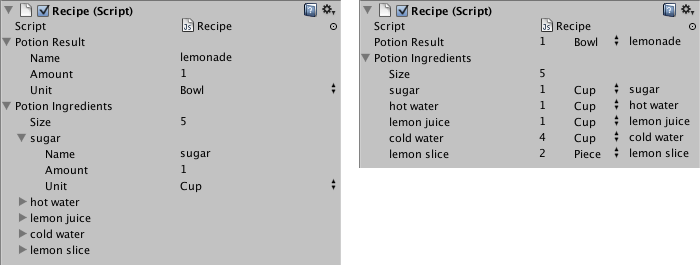Description
カスタムプロパティドローワーのベースクラスです。自身で作成した Serializable クラスや PropertyAttribute 変数のカスタムドローワーを作成して使用することが出来ます。
PropertyDrawersは 2 つの使い方があります:
- Serializable クラスのGUIをカスタマイズ
- PropertyAttribute の付いたスクリプトメンバーのGUIをカスタマイズ
自身で作成した Serializable クラスを持つ場合、Inspectorの見た目を変更できるPropertyDrawerを使用することが出来ます。
SerializableクラスのIngredientクラスを考慮したスクリプトが以下になります:
// Recipe.js
// This is not an editor script
enum IngredientUnit { Spoon, Cup, Bowl, Piece }
// Custom serializable class
class Ingredient extends System.Object {
var name : String;
var amount : int = 1;
var unit : IngredientUnit;
}
var potionResult : Ingredient;
var potionIngredients : Ingredient[];
function Update () {
// Update logic here...
}
using UnityEngine; using System.Collections; public class Ingredient : MonoBehaviour { public string name; public int amount = 1; public IngredientUnit unit; } public class ExampleClass : MonoBehaviour { public Ingredient potionResult; public Ingredient[] potionIngredients; }
import UnityEngine import System.Collections public enum IngredientUnit: Spoon Cup Bowl Piece public class Ingredient(System.Object): public name as string public amount as int = 1 public unit as IngredientUnit public class ExampleClass(MonoBehaviour): public potionResult as Ingredient public potionIngredients as (Ingredient)
PropertyDrawerを使用すると、Ingredientクラスの状況によってInspectorを変更することが可能です。
PropertyDrawerを使った場合と使っていない時のIngredientクラスのInspectorを比較してみてください:

PropertyDrawerを使用していない (left) 時と使用している (right) 時のクラスのInspectorの表示
PropertyDrawerは CustomPropertyDrawer アトリビュートとドローワーを使用するSerializableクラスの型をアタッチします。
// IngredientDrawer.js @CustomPropertyDrawer (Ingredient) class IngredientDrawer extends PropertyDrawer { // Draw the property inside the given rect function OnGUI (position : Rect, property : SerializedProperty, label : GUIContent) { // Using BeginProperty / EndProperty on the parent property means that // prefab override logic works on the entire property. EditorGUI.BeginProperty (position, label, property); // Draw label position = EditorGUI.PrefixLabel (position, GUIUtility.GetControlID (FocusType.Passive), label); // Don't make child fields be indented var indent = EditorGUI.indentLevel; EditorGUI.indentLevel = 0; // Calculate rects var amountRect = new Rect (position.x, position.y, 30, position.height); var unitRect = new Rect (position.x+35, position.y, 50, position.height); var nameRect = new Rect (position.x+90, position.y, position.width-90, position.height); // Draw fields - passs GUIContent.none to each so they are drawn without labels EditorGUI.PropertyField (amountRect, property.FindPropertyRelative ("amount"), GUIContent.none); EditorGUI.PropertyField (unitRect, property.FindPropertyRelative ("unit"), GUIContent.none); EditorGUI.PropertyField (nameRect, property.FindPropertyRelative ("name"), GUIContent.none); // Set indent back to what it was EditorGUI.indentLevel = indent; EditorGUI.EndProperty (); } }
no example available in C#
no example available in Boo
PropertyDrawerの他の使い方は PropertyAttribute の付いたメンバーの外観を変更することが出来ます。 例えば整数で特定の範囲内で値を設定したい場合に、Inspectorにはスライダーとして表示することが出来ます。 これは RangeAttribute としてビルドインされているPropertyAttribute機能でこのように使用します:
// Show this float in the Inspector as a slider between 0 and 10 @Range (0.0, 10.0) var myFloat = 0.0;
using UnityEngine; using System.Collections; public class ExampleClass : MonoBehaviour { [Range(0.0F, 10.0F)] public float myFloat = 0.0F; }
import UnityEngine import System.Collections public class ExampleClass(MonoBehaviour): [Range(0.0F, 10.0F)] public myFloat as float = 0.0F
自分で PropertyAttribute を作成することも出来ます。 RangeAttribute を実装例として参考にしてください。 このアトリビュートはPropertyAttributeクラスを継承する必要があります。必要であればこのアトリビュートクラスにパラメータや変数の値を保持しておくことが出来ます。
// This is not an editor script. The property attribute class should be placed in a regular script file. class RangeAttribute extends PropertyAttribute { var min : float; var max : float; function RangeAttribute (min : float, max : float) { this.min = min; this.max = max; } }
アトリビュートを作成したら次はアトリビュートを持つプロパティの描画のためにPropertyDrawerを作成する必要があります。 このドローワークラスはPropertyDrawerを継承することと、 CustomPropertyDrawer アトリビュートを付ける必要があります。
// The property drawer class should be placed in an editor script, inside a folder called Editor. // Tell the RangeDrawer that it is a drawer for properties with the RangeAttribute. @CustomPropertyDrawer (RangeAttribute) class RangeDrawer extends PropertyDrawer { // Draw the property inside the given rect function OnGUI (position : Rect, property : SerializedProperty, label : GUIContent) { // First get the attribute since it contains the range for the slider var range : RangeAttribute = attribute as RangeAttribute; // Now draw the property as a Slider or an IntSlider based on whether it's a float or integer. if (property.propertyType == SerializedPropertyType.Float) EditorGUI.Slider (position, property, range.min, range.max, label); else if (property.propertyType == SerializedPropertyType.Integer) EditorGUI.IntSlider (position, property, range.min, range.max, label); else EditorGUI.LabelField (position, label.text, "Use Range with float or int."); } }
no example available in C#
no example available in Boo
パフォーマンス上の理由からEditorGUILayoutクラスはPropertyDrawerでは使用できないことに注意してください。 See Also: PropertyAttribute クラス, CustomPropertyDrawer クラス.
Variables
| attribute | プロパティの PropertyAttribute を取得します (Read Only) |
| fieldInfo | このプロパティが表すメンバーのリフレクション FieldInfo (Read Only) |
Functions
| GetPropertyHeight | ピクセル単位でGUIの高さを設定します。そのためにはこのメソッドをオーバーライドしてください |
| OnGUI | 独自のGUI描画を作成するためにこのメソッドをオーバーライドします |